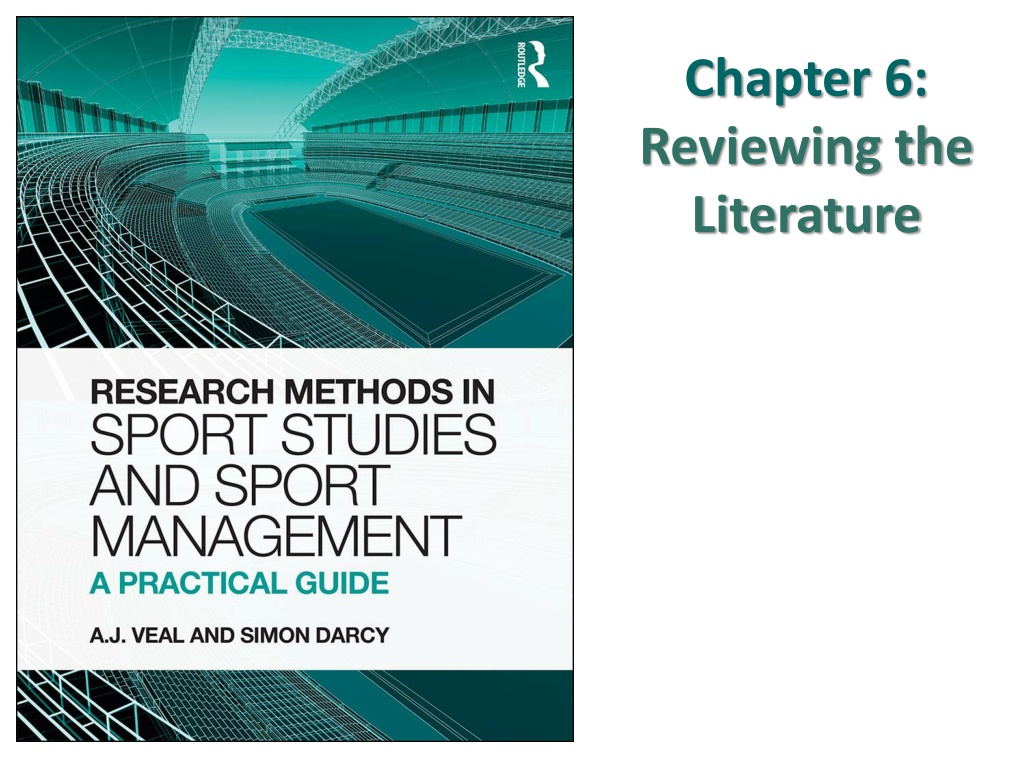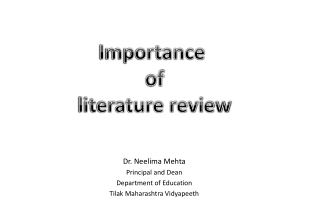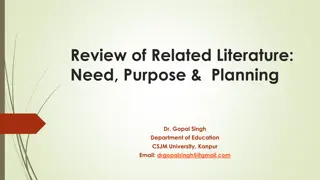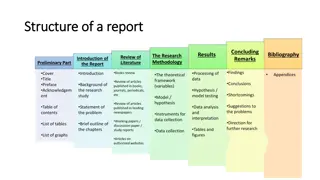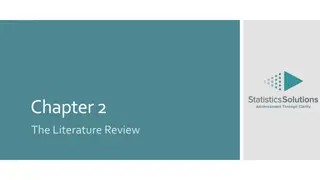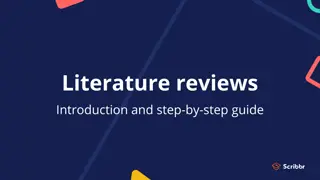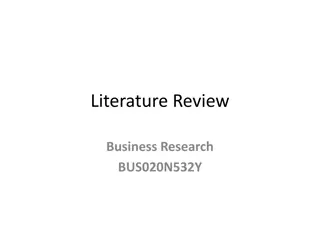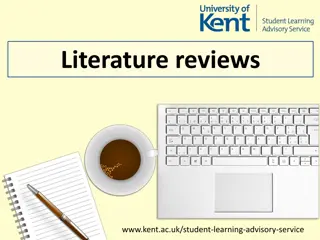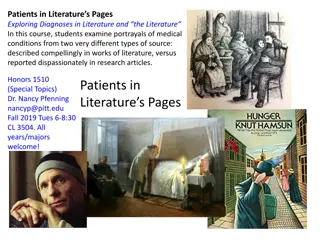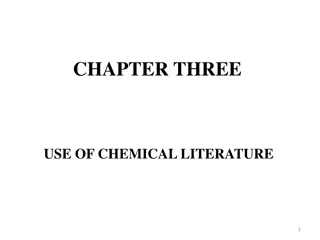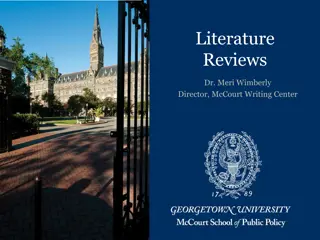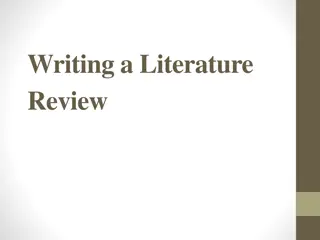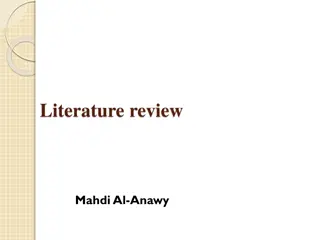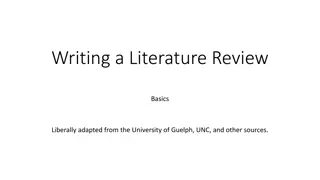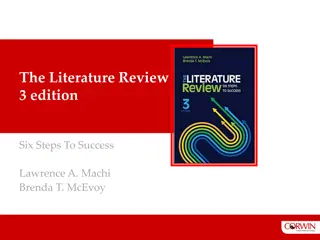Understanding the Importance of Literature Review in Research
Exploring the roles of literature in research, this content emphasizes the significance of reviewing existing literature to gather ideas, compare methodologies, and integrate supportive information. It also highlights the types of reviews and essential questions to consider during the literature review process in academic research.
Download Presentation

Please find below an Image/Link to download the presentation.
The content on the website is provided AS IS for your information and personal use only. It may not be sold, licensed, or shared on other websites without obtaining consent from the author. Download presentation by click this link. If you encounter any issues during the download, it is possible that the publisher has removed the file from their server.
E N D
Presentation Transcript
Chapter 6: Reviewing the Literature
Roles of the literature in research (Fig. 6.1) The entire basis of the research Source of: ideas on topics for research information on research already done by others methodological or theoretical ideas comparison between your research and that of others information that is an integral or supportive part of the research for example statistical data on the study area population A. J. Veal & S. Darcy (2014) Research Methods for Sport Studies and Sport Management: A practical guide. London: Routledge
Sources of information (Fig. 6.2) Library catalogues Specialist indexes & electronic databases The Internet Google Scholar Published bibliographies General sport studies/management books Reference lists Beyond sport Unpublished research A. J. Veal & S. Darcy (2014) Research Methods for Sport Studies and Sport Management: A practical guide. London: Routledge
Compiling and maintaining a bibliography It is good practice to develop and maintain a personal bibliographic database. Always record full details. Use of software, such as Endnote, is worthwhile. It should only be necessary to type out a reference once in your life! A. J. Veal & S. Darcy (2014) Research Methods for Sport Studies and Sport Management: A practical guide. London: Routledge
Reviewing the literature Types of review (Fig. 6.3) Inclusive everything written on the topic Inclusive/evaluative as 1. + your commentary Exploratory finding out what is known/ not known focus on a question/issue Instrumental finding convenient, up-to-date source for a theory/framework/summary Content analysis/hermeneutics technical, analytical analysis of texts A. J. Veal & S. Darcy (2014) Research Methods for Sport Studies and Sport Management: A practical guide. London: Routledge
Questions to ask when reviewing (Fig. 6.4) Individual items: Empirical basis of the research? Relationships to other writing on the topic? Theoretical framework being used? Geographical area covered? Social group(s) included? When conducted? Still valid? A. J. Veal & S. Darcy (2014) Research Methods for Sport Studies and Sport Management: A practical guide. London: Routledge
Questions to ask when reviewing contd The literature as a whole: Range of research conducted? Methods generally used? Methods neglected? What does the research tell us? What does the research not tell us? Contradictions in the literature? Deficiencies - substantive or methodological? A. J. Veal & S. Darcy (2014) Research Methods for Sport Studies and Sport Management: A practical guide. London: Routledge
Summarising/Making sense (Fig. 6.5) Data set B Related issue Data set A Main Topic/Issue Sub-theme X Theory A Sub-theme Y Theory B A. J. Veal & S. Darcy (2014) Research Methods for Sport Studies and Sport Management: A practical guide. London: Routledge
Referencing the literature Generic reference format (Fig. 6.6) A book or report: Author(s), Initials (Year) Title of Book or Report in Italics. Place of publication: Publisher. NB Publisher is not the same as printer. An article from a periodical (journal/ magazine/newspaper): Author(s), Initials (Year) Title of article. Title of Periodical in Italics, Volume number (Issue number), Page numbers. A. J. Veal & S. Darcy (2014) Research Methods for Sport Studies and Sport Management: A practical guide. London: Routledge
Generic reference format (Fig. 5.7) A book or report: Author(s), Initials (Year) Title of Book or Report in Italics. Place of publication: Publisher. NB Publisher is not the same as printer. An article from a periodical (journal/ magazine/newspaper): Author(s), Initials (Year) Title of article. Title of Periodical in Italics, Volume number (Issue number), Page numbers. A. J. Veal & S. Darcy (2014) Research Methods for Sport Studies and Sport Management: A practical guide. London: Routledge
Two referencing systems Author-date or Harvard system Footnote or endnote system A. J. Veal & S. Darcy (2014) Research Methods for Sport Studies and Sport Management: A practical guide. London: Routledge
Comparing the two systems Feature Harvard/Author-date Footnote/Endnote Superscript number, e.g.: 1 Reference in text Author (date) Reference format Author (date) Title. Publishing details. 1. Author Title. Publishing details, date Reference list format Alphabetical list at end of report Numbered list at: - foot of pages, or - end of chapters, or - end of report Advantages - alphabetical bibliography - easy to use - date of publication seen in text - unobtrusive in text - can add other notes/ comments Disadvantages - obtrusive in text - can t add notes - no alphabetical bibliography A. J. Veal & S. Darcy (2014) Research Methods for Sport Studies and Sport Management: A practical guide. London: Routledge
